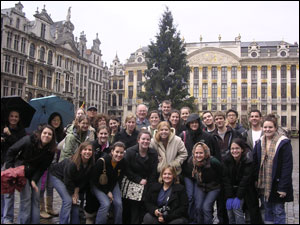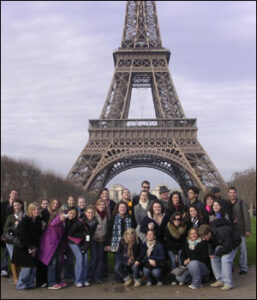European Media Study Tour 2007

An Insider’s View of an Unparalleled International Experience
Elizabeth Brixey, assistant professor and city editor at the Columbia Missourian, was one of three Missouri School of Journalism faculty members leading 25 students through four countries during the 2007 European Media Study Tour Dec. 31, 2006-Jan. 15, 2007. The annual tour offers students a chance to visit top international media outlets while absorbing the culture of life abroad. Here Brixey reflects on the highlights of the trip, from the demanding travel schedule to the unique culinary delights – and most importantly, the cultural experience that will last a lifetime.
Columbia, Mo. (March 14, 2007) — We were still 15 minutes out of Heidelberg when the anxiety about getting off the train hit in earnest. We were 29 people, with 29 bulging suitcases and 29 backpacks and other bags. We had four minutes to get off the train.

We did it in 40 seconds.
Well, I say “we,” but it was really the guys on the trip – Eugene Phua, Charlie Hart, Andy Paschen, Michael Stonacek and Mark Stanley. A human assembly line, they piled, tossed, hurled and heaved the bags down through a tunnel-like doorway and onto a cement platform. Waiting there were the rest of us, who grabbed the bags and lined them up. Julia Wald tried to take a picture, but it came out a blur.
“I’ve never seen anything like that,” Brian Brooks, associate dean of the School of Journalism, said later. “That was amazing.”
This was the European Media Study Tour 2007. Twenty-five undergraduates, three faculty members from the School of Journalism and Brooks’ wife, Anne, took planes, trains, buses and cars to visit Belgium, France, Austria and Germany. We flew into Brussels, rode the high-speed “Thalys” train to Paris, took a 13-hour sleeper train to Vienna, got back on the train to stop in Munich overnight and then went on to Heidelberg for the final four days. Are you tired yet? We were.

We visited newspapers including the Wall Street Journal Europe in Brussels, 20 Minutes in Paris and the über-equipped newcomer Osterreich in Vienna; magazines such as Paris Match and the German Glamour; the Austrian Broadcasting Co. and France Television; and advertising agencies M&C Saatchi GADin Paris and Traktor in Vienna – both of which were so creative and cool that we on the journalism end fantasized briefly about lives in advertising.
As a group, we toured the Louvre in Paris (the “Mona Lisa” had just returned from her own travels abroad); the Gutenberg Museum in Mainz, Germany, which honors the European inventor of printing with movable type; and the formidable Heidelberg Castle, which overlooks a perfectly charming town along the Neckar River – those of you of a certain age, remember “The Student Prince?”
And yes, there was Wiener schnitzel in Vienna, croissants in Paris, chocolate (and mussels) in Brussels and sauerbraten in Heidelberg. A few of us became overly fond of the overly long hotdogs (they called them something else) sold at the metro stations.

Some of the tour’s most remarkable memories began as last-minute adventures the students undertook themselves. That happened in Munich, where we stopped for less than 24 hours. We blew in just in time for a late-afternoon visit to Glamour. Editor Nikolaus Albrecht later wrote to magazine professor John Fennell, who was on the trip, “I have rarely met a group which was so fresh, open, interested and asked just the right questions. It was a very inspiring hour for me.” But the next morning, with only a matter of hours before we again boarded a train, two groups of students set off for the Munich suburb of Dachau, where one of the World War II concentration camps is located.
“Walking through the gates where people went in and most likely didn’t come out was incredibly difficult,” Madeline Johnston, a senior in magazine writing, said later. “It was cold and miserable and windy, and I had on three layers of clothing; and I thought what would I have done with just paper-thin ‘bags’ on me and no food.”

“It was one of the most intense experiences of my life,” she recalled. “It made it all real, and it made it personal to someone whose heritage doesn’t have a direct connection to anything that happened there.”
That’s what Brian Brooks had in mind when he started the European Media Study Tour four years ago. The students were exhausted when they got back this year, but they also had an energy from their experiences that carried them through the first weeks of the semester. For the trip’s academic requirements, they created projects including ad campaigns for the tour, a “how to travel in Europe video,” a restaurant review guide and a book of photographs. But the lasting benefit is potentially life-altering: looking at the United States from a new perspective and participating in something more of the world.
Updated: April 16, 2020